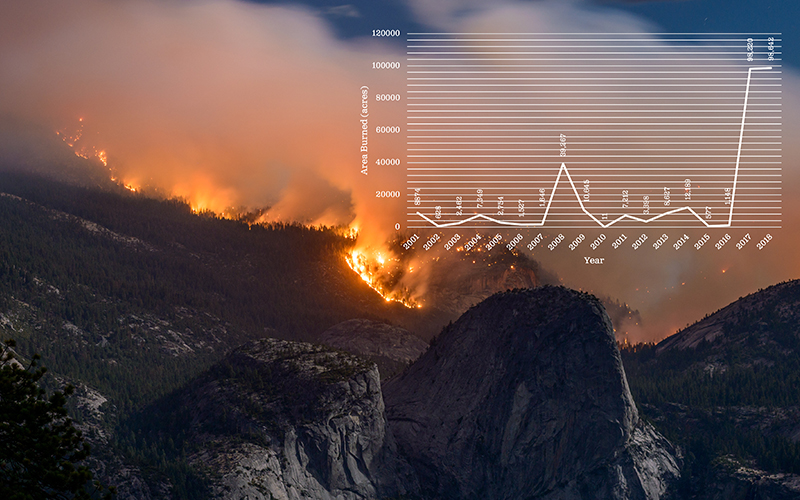 ASLA 2021 Professional Analysis and Planning Honor Award. Recreation at the Intersection of Resilience – Advancing Planning and Design in the Face of Wildfire. Mariposa County, California. Design Workshop, Inc.
ASLA 2021 Professional Analysis and Planning Honor Award. Recreation at the Intersection of Resilience – Advancing Planning and Design in the Face of Wildfire. Mariposa County, California. Design Workshop, Inc.The American Society of Landscape Architects (ASLA), which represents 15,000 landscape architects, is dismayed by the slow, incremental progress made by world leaders at the United Nations Climate Change Conference (COP26), in Glasgow, Scotland, towards achieving a 1.5°C limit to global warming.
According to the well-regarded Climate Action Tracker, commitments by countries as part of their Nationally Determined Contributions (NDCs) would currently result in an increase of at least 2.4°C of warming by 2100. The group states that “with all target pledges, including those made in Glasgow, global greenhouse gas emissions in 2030 will still be around twice as high as necessary for the 1.5°C limit.” Furthermore, “stalled momentum from leaders and governments on their short-term targets has narrowed the 2030 emissions gap by only 15-17% over the last year.”
“Landscape architects are disappointed by the lack of progress and ambition at COP26,” said Tom Mroz, FASLA, ASLA President. “While there were some positive steps taken, including the recognition of the role of nature and nature-based solutions in addressing climate change, there is zero time to waste in getting on a path to cutting emissions by 50%, at a bare minimum, by 2030. The impacts of wildfires, extreme heat, flooding, and other forms of climate change on our communities and natural environments only continue to worsen.”
ASLA acknowledges some limited progress occurred at COP26. The Glasgow Climate Pact, signed by over 200 countries, includes a commitment to update NDCs and ratchet up greenhouse gas emission reduction targets next year at COP27 in Egypt, rather than waiting until 2025, as previously agreed as part of the Paris Climate Accord.
The importance of ecosystems in addressing climate change was also recognized and incorporated into the pact. World leaders highlighted the key role of healthy terrestrial ecosystems, particularly forests, wetlands, and prairies, in both reducing greenhouse gas emissions and helping communities adapt to climate change.
Also, a clear connection was made between the worsening climate and biodiversity crises. Countries recognized that preserving and restoring ecosystems is crucial to protecting the world’s remaining biodiversity. Indigenous communities managing much of the world’s remaining intact ecosystems should play a lead role in future conservation efforts.
This text in the pact was a step forward:
[The Conference of the Parties] emphasizes the importance of protecting, conserving, and restoring nature and ecosystems, including forests and other terrestrial and marine ecosystems, to achieve the long-term global goal of the Convention by acting as sinks and reservoirs of greenhouse gases and protecting biodiversity, while ensuring social and environmental safeguards.”
“World leaders need to do much more to address both climate change and biodiversity loss. With greater ambition and support at the national level, landscape architects can do even more to achieve key climate goals through large-scale ecological planning and design,” said Torey Carter-Conneen, ASLA CEO.
ASLA also supports additional coalition pledges announced at the Glasgow conference:
Ending Deforestation by 2030: More than 100 world leaders, representing 85% of the world’s forests, agreed to end and reverse deforestation and land degradation by 2030. Twelve countries have committed $12 billion of public funds and companies have committed an additional $7.2 billion in private investment for conservation and restoration, including $1.7 billion for Indigenous peoples. In the U.S., House Majority Leader Stenny Hoyer introduced legislation that would establish a $9 billion trust fund at the U.S. State Department to finance bilateral forest conservation efforts in developing countries.
“Since the very beginning of our profession with Frederick Law Olmsted, landscape architects have focused on conserving and restoring ecosystems and enhancing biodiversity,” Mroz said. “We can play a critical role in helping all communities protect and restore ecosystem functions, particularly those that lack green spaces.”
Global Methane Pledge: More than 100 world leaders also committed to reduce emissions of methane, one of the most potent greenhouse gases, by 30% by 2030, as part of an initiative led by the U.S. and European Union. According to EU estimates, a 30% cut in methane emissions could reduce projected warming by 0.2°C (0.36°F). The pledge covers countries that are responsible for 50% of all methane emissions. Methane is released from livestock, agriculture, the production of natural gas, and landfills.
“Communities impacted by landfills are typically among the most historically marginalized and underserved. Landscape architects have proven they can plan and design solutions that safely capture methane emissions from landfills. We can help more communities around the world transform toxic garbage dumps into green spaces that capture and store methane,” Carter-Conneen said.
Landscape architects plan and design with nature to help all communities reduce greenhouse gas emissions and adapt to a changing climate. Landscape architects use Climate Positive Design approaches that transform parks and open spaces into natural carbon sinks. They develop resilient nature-based solutions that reduce the impacts of extreme heat; coastal, ground, and inland flooding; sea level rise; pollution; and wildfires. They also increase biodiversity and protect and restore ecosystems, which underpin life on Earth. Learn more at: https://climate.asla.org